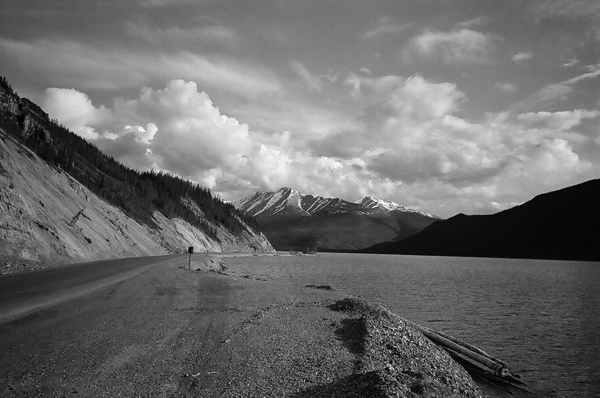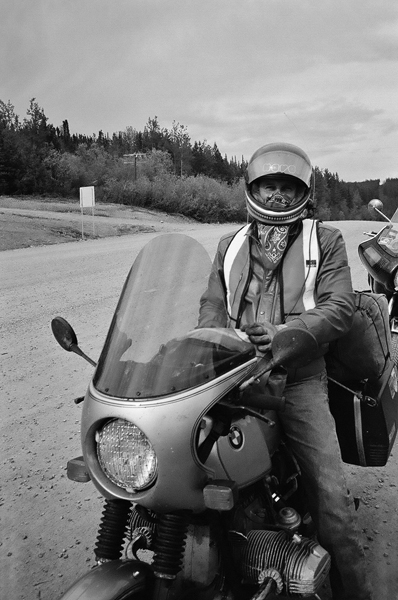We were somewhat re-Americanized today. I was rather surprised, and at first I did not even make the flimsy connection to it being the Alaskan Highway. We were still in the depths of British Columbia, so there theoretically should not have been a correlation between the road’s environment and the road’s American-based namesake. And, granted, there probably was no correlation except for the accommodations made to American tourists in RVs. The number of flying American flags on flagpoles was somewhat surprising. The rippling power of the US could be felt best in other countries.
Within a few miles of starting out this morning, I quickly noticed how the intersections, country stores, gas pumps, and Detroit chariots (which had conquered this market) were photocopied from a generic part of any unnamed united state. Only the international symbol signs and products labeled in English with a complete repeat of everything in French told us that we were not in Kansas anymore, Toto.
The strangest thing was how the landscape had changed. The coniferous trees were taken over in great numbers by deciduous trees, giving us forests to pass through that were like our short Sunday rides at home. Even the hills themselves could have easily been mistaken for the Black Hills of South Dakota. Later in the day, the conifers regrouped and darkened the hills again.
The scenes transformed, however, and I grew very impressed with what the Alaskan Highway had to show. Even areas which were not officially labeled and zoned as “parks” could easily have passed for “park land”. However, long tracts were overrun with thin-pole conifers that had some spindly greens on them so that no one would question whether they were trees or giant hairy toothpicks, all the result of poorly thinned post-logging forest growth. Many areas had the aftereffects of forest fires, including signs along the road with constant warnings. Varying degrees of re-growth or human-planned clearing and re-planting were interspersed throughout. The land slowly flowed from “America” to rolling northern forests and on to such extremes as hyperactive Badlands-bald mountains and snow-capped lunar peaks. It all required some looking, but there was a lot to find.
As to the famed Alaskan Highway rough-and-tumble hell-road myth: was it myth or was it real? For that first day the answers came from different perspectives, depending on one’s mode of transport. In a pickup truck, it would have been no big deal. You just needed to plan on some nicks in the paint and possibly a star-cracked windshield. On motorcycles, the road was very rideable, but required finesse. A majority of it was roughly paved. So roughly, in fact, that I sometimes found it difficult to tell if I was coming upon gravel-covered roadway or gravelly-looking, yet firm, pavement. Loose gravel over pavement gave our bikes the jitters, and loose gravel over dirt was much worse. Simple pavement or simple packed dirt would have been just dandy for me and my mount, but presumably the frost heaves and permafrost eventually crumbled regular pavement back to gravel anyhow. At least that’s what I assumed was the reason for using taxpayer money to spread out miles and tons of small rocks and dust.
I just mentioned dust. I did that for a reason: there was lots of it. Passing cars and trucks going the other way gave my lung’s cilia a workout. Dad took the wild west outlaw approach and fixed a red patterned bandana around his head and over his nose and mouth. I was planning to noose myself up with one the next day too.
We ended up in the bustling “metropolis” of Muncho Lake, which lacked people and buildings but was a good place for a rest stop. In the evening before bed I was surrounded by the insulated, log cabin style walls of a room at the J&H Wilderness Resort. Sheesh, that name was stupid. “Wilderness Resort”. Nice oxymoron.
It did include a hot shower, though, along with RV hookup sites and small boat rentals for the lake. At least the shower was useful. The last hour on the road beforehand had been spent in cold rain, with Dad’s BMW intermittently running on one of two cylinders. Accumulated dust and chill was solved by the hot water running down our backs, and non-firing cylinder problems were solved by a change of spark plugs that evening.


